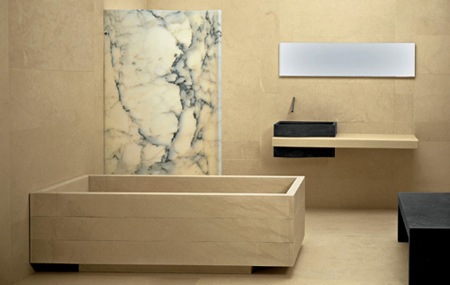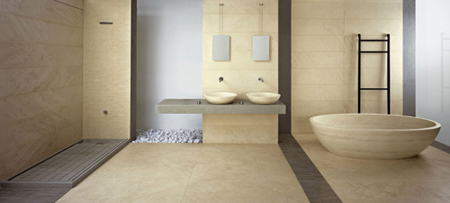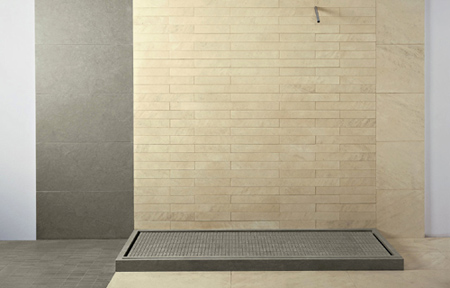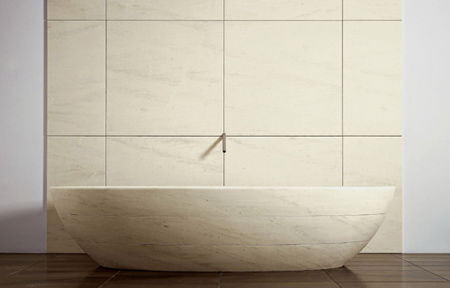26 Settembre 2008
English
Body, stone, bathroom

Bathroom with natural stone coverings and fixtures projected and produced by PIBA Marmi. Citrohan bath in Granada Beige, Jeanneret basin and Dominò bench in velvety finished Nero Assoluto, shower partition wall in Statuario Venato.
Sensorial characteristics of natural stone materials, jointly with the complex patrimony of intellectual values that they conserve in the common imaginary, create nowadays a renewed interest in objects design and stone environments that get a particular functional and symbolical meaning in contemporary society.
Analyzing this phenomenon, our attention must concentrate on the product as a constitutive element of a complex spatial, social and even cultural context, rather than on the design product as the simple result of a productive process; and this perspective can be faced in parallel to design characteristics and body dimensions of the 3rd-millennium observer.
On one hand it can be said that contemporary trends are based on dematerialization of the processes, on the other hand they’re almost maniacally interested in body and mind dimension in human life and in its expressive and sensorial dynamics; this condition is well represented on global mass media communication (from periodic press to television news; from luxury brands refined policies to more extensive advertisement campaigns) that heavily influences individual perception of the subject always more frequently referring to physicality and both body and mind care.
In this way products and wellness-related practices become signs of distinction in a new sort of organicism, able to redesign human sensorial and emotive experiences. So the places traditionally dedicated to body “worship” assume a new centrality and undergo important changes in structure and image: in the private or in the public scene (spas, wellness and fitness centres, …), bathrooms become devoted places to body care practices going beyond simply hygienic needs and getting therapeutical functions and aesthetical metamorphosis aims.

Bathroom with natural stone coverings and fixtures designed and produced by PIBA Marmi. Tinozza bath and Catino basin in Pietra Zen, Idro shower plate in Grigio Ash.
[photogallery]piba_album_1[/photogallery]
As already happened for other functional environments, bathroom idea as well is opening and expanding: its merely functional conception fades, body care spaces become sophisticated and complex, funding with restroom for instance; its typological and functional partitions become less important in favour of entertainment and body care activities, once destined only to living and welcoming rooms; if the bathroom was in past times considered as an invisible part of the house, now it’s converted in a room of exposed visibility. Its objects and hygienic fixtures get an expansion of meaning: basins become plastic objects; baths get bigger dimensions and are hybrid manufactures between traditional water container and swimming pool; shower plates amplify and become real inhabitable places. In this way are basins simply hydraulic supplies or design furnishing? Are the baths hydraulic dispositives or sculptures?
The quality imposed by new design tendencies become scarcely measurable, hardly fitting a functional objectivity, but it’s the measure of the complex and articulated relationship between object and subject.
In fact “after the separated bathroom scheme, we are going towards an inclusive and experimental bathroom idea, that assumes this difference as a typological and iconic research stimulation. The project surpasses “good design” conception or the idea of a social sharable product thanks to its ergonomics: technological support can help concentrating on complex creative and unconventional scenes, result of a deep manipulation of products and rooms existent typologies. The quality of bathroom-product depends on its ability of creating emotions: that’s no more a technical or functional question, but a question of contents and forms chemistry.”1

Idro shower plate in natural stone designed and produced by PIBA Marmi
It’s easy to comprehend that, in such a scene based on immediate multisensory stimulation or on the joy of a prolonged environmental perception, natural materials are enjoying a renewed success to the detriment of industrial materials that “exclude bodies, offer no occasion to history, don’t get enriched by ageing, don’t let memory be stimulated, with the result of being indifferent, neuters and odourless substances”.2
Stone can find its privileged application expanding its potentialities at visual, but also tactile, auditory and olfactory levels. If normally architecture involves just vision as the main relationship with the objects, bathroom contemporary design privileges previously unseen interaction between human beings and a synaesthetical material world; stone coverings or floors to be experienced naked in baths or at the board of the polls, that can be smooth or rough, warm or frozen, dry and coarse or wet and slippery; cave or massive stones that can sound differently depending on the way water flows or hits them; or yet, in closed and separated environments, hot, vapour-surrounded stones can contribute to olfactory sensations.
Stone materials, if observed, touched, smelt or “listened to”, are more and more frequently employed in order to activate a huge range of emotional and perceptive stimulations and to induce in the observer ancestral values and memories, linked to the identity of human origins. And if new wellness temples are presented as complex habitats, always more artificial, multifunctional and multiexperimental, in the opposite product typologies as basins, baths or other stone fixtures are adapted to essential and rigorous languages, with a low-profile visual impact, preferring a friendly relationship with users rather than a functional exhibitionism: observers are involved in wrapping, stereometrical, smooth and clear forms, in “soft” and polished surfaces, in stimulating and tactile perceptions.
This sculptural presences are obtained in most part by the excavation of entire monoliths through progressive absportation of material by numerically-controlled machinery. Perfection, continuity and flexibility of the cutting allow to obtain net bathroom fixtures, pure and homogenic plastic bodies with volumetric contrapositions, chiaroscuro effects of lights and shadows. Most employed materials in contemporary design are dark volcanic stones, grey arenaria, red or golden limestones, dark or light Italian travertinos, Carrara marbles, Verde Alpi and Nero Assoluto.

Tinozza bath in natural stone designed and produced by PIBA Marmi.
[photogallery]piba_album_2[/photogallery]
3rd-millennium bathrooms are characterized by a silent and rarefied opulence in which hygienic, aesthetical and meditative practices are approached abandoning traditional rigid wall separation between traditional rooms in favour of dilated and filtering spaces, defined by translucent stone materials.
Stone materials are presented in a archipelago of technical, functional and symbolic elements that give life to a bathroom-system in order to materialize solidity, purity, naturality and stability; but in this total design concept, stones also cover surfaces that define the rooms, displaying flamboyant and spectacular chromatic characteristics or less extraordinary high-quality structural frames that likewise express strong and penetrating physical and psychical sensations. This subtle conception collocate stone materials in the new luxury design world not conceived to create mere appearances, but to improve lifestyle standards of the people that bought them.
If throughout history stones have always embodied values of prestige, richness, splendour and showy opulence, nowadays they contribute to shape a new quality in the contemporary luxury based on alternative ideas of wellness, sensorial fruition, real physical and mental pleasure, in a equilibrium of naturality and simplicity exalted by technology. In the 3rd millennium, stone “precious” objects must transmit an idea of approach to the most intimate desires of the buyer and they must, in conclusion, satisfy the subject in perceptive and introspective terms.3
by Davide Turrini
Notes
1 Gianluca Sgalippa, Post-bagno. Corpo, ambiente e design nell’età delle mutazioni tipologiche, Milano, Tecniche Nuove, 2006, p. 65.
2 David Le Breton, Antropologia del corpo e modernità, Milano, Giuffrè, 2007, p. 120, (tit. or. Antropologie du corps et modernitè, 2000).
3 About values, limits and metamorphosis of contemporary luxury: Giovanni Cutolo, Lusso e Design. Etica, estetica e mercato del gusto, Milano, Abitare Segesta, 2003, pp. 130.
